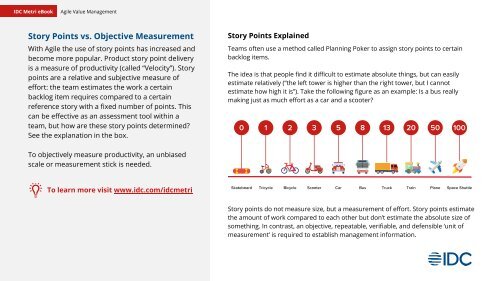IDCMetri_AVM_eBook
Create successful ePaper yourself
Turn your PDF publications into a flip-book with our unique Google optimized e-Paper software.
IDC Metri <strong>eBook</strong><br />
Agile Value Management<br />
Story Points vs. Objective Measurement<br />
With Agile the use of story points has increased and<br />
become more popular. Product story point delivery<br />
is a measure of productivity (called “Velocity”). Story<br />
points are a relative and subjective measure of<br />
effort: the team estimates the work a certain<br />
backlog item requires compared to a certain<br />
reference story with a fixed number of points. This<br />
can be effective as an assessment tool within a<br />
team, but how are these story points determined?<br />
See the explanation in the box.<br />
Story Points Explained<br />
Teams often use a method called Planning Poker to assign story points to certain<br />
backlog items.<br />
The idea is that people find it difficult to estimate absolute things, but can easily<br />
estimate relatively (“the left tower is higher than the right tower, but I cannot<br />
estimate how high it is”). Take the following figure as an example: Is a bus really<br />
making just as much effort as a car and a scooter?<br />
To objectively measure productivity, an unbiased<br />
scale or measurement stick is needed.<br />
To learn more visit www.idc.com/idcmetri<br />
Story points do not measure size, but a measurement of effort. Story points estimate<br />
the amount of work compared to each other but don’t estimate the absolute size of<br />
something. In contrast, an objective, repeatable, verifiable, and defensible ‘unit of<br />
measurement’ is required to establish management information.















